
Many North Koreans are quite upset about being forced to bear the cost of building a large-scale greenhouse farm in Hamju County, South Hamgyong Province.
A source in South Hamgyong Province told Daily NK on Friday that Yonpo Greenhouse Farm, as the complex is known, is even bigger than the greenhouse farm previously erected in Chungpyong District, North Hamgyong Province. However, he said local residents are shouldering a huge burden with localities tasked with funding construction.
North Korea previously announced plans to create a modern vegetable farm on the grounds of a military base in Yonpo District, Hamju County, to improve the diet of local residents. It has even promoted the project as one of the most important construction policy tasks of the year.
In fact, North Korean leader Kim Jong Un attended the groundbreaking ceremony of the farm on Feb. 18. He said the Central Committee had decided to transform an important military base on the eastern front line into a modern vegetable farm. He explained that a new farming district would take form with new housing in various forms for roughly 1,000 households and unique public buildings such as schools, cultural halls, and service facilities.
Yonpo Greenhouse Farm is being built on a former military air base, much like Chungpyong Vegetable Greenhouse Farm, which was completed two years ago.
According to the source, North Korea plans to build homes for about 970 families and 130 public buildings and production structures on roughly three million square meters of land. Kim has instructed that this massive construction project be completed by Oct. 10 — North Korea’s Party Foundation Day.
In his speech at the groundbreaking, Kim emphasized his desire to see the project completed by the Oct. 10 deadline with calls for the “Yonpo Creative Spirit” and “Fiery Wind of Yonpo.” He also called on the authorities of South Hamyong Province to “actively join forces” in order to build the farm.
Kim said even though the army had been entrusted with building the farm, South Hamgyong Province would benefit from the project, so provincial authorities should contribute as much as they can. He called on the province to ensure sufficient supplies of aggregate, to plant wind-breaking forests for the coastal complex and to provide other forms of support to promote construction of the farm.
Accordingly, South Hamgyong Province has begun gathering construction supplies through local bodies and enterprises.
The source said as soon as the construction headquarters formed, provincial bodies and enterprises were given quotas of construction materials and supplies needed to produce greenhouse equipment. He said local residents are bearing the entire cost of procurement, and that the government bodies and enterprises are expected to pony up about USD 30 per employee in “absolutely obligatory” supply contributions.
According to North Korea’s market exchange rate and market prices as regularly determined by Daily NK, USD 30 was about KPW 190,000 as of Feb. 20, roughly the cost of 40 kilograms of rice. That is a considerable sum for North Koreans suffering economic distress due to the closure of the China-North Korea border in the wake of COVID-19.
The source said for employees to achieve their quotas, a family of four would have to starve for two months. He said with locals facing not only corvée labor at the construction site, but now material and financial contributions as well, the burdens of the Yonpo Greenhouse Farm project are mounting.
Please direct any comments or questions about this article to dailynkenglish@uni-media.net.

















